Where’s Bill? #CAST2023
I’m writing this newsletter from the road … literally ... sitting in the back seat of a Wagoneer heading up the California Coast with my friends and coworkers at Ball Publishing, Chris Beytes, Jen Zurko and Osvaldo Cuevas. We’re out here covering the 2023 California Spring Trials, learning about the new introductions coming to market for 2024.

We started on Tuesday, and by the time you get this newsletter, we’ll be about a day away from completing our five day (and night) journey. Hopefully, you’re receiving (and reading) our daily newsletter, Acres of buZZ!, which takes you day by day through the trial stops. I might be a bit biased, but I think it’s the most thorough coverage you can find. If you aren’t getting the newsletter in your inbox, check out the ARCHIVES HERE.
AND … we make videos for just about every exhibiting company! Not only do we show off the best new varieties, but we also have a bit of fun on camera (after all, life is too short for boring new-variety videos). You can find the FULL PLAYLIST HERE. If you’re on Instagram, you can follow us for plant pics @GrowerTalksGreenProfit. And like us on FACEBOOK to follow our journey.

Nick’s Tip of the Week: Managing pH in Patio Pot Production
Each week, I’ll work with my buddy Nick Flax, a technical services expert at Ball, to share a concern that’s come up during one of his numerous calls with growers across North America. This week, he’s sharing pH info for those of you growing big, showy patio pots this spring.
PROBLEM: The long amount of time your production team spends growing out large patio pots for impulse purchases at retail means your crops could be prone to high-pH-induced iron (Fe) deficiency. Petunia and calibrachoa are the usual suspects for this disorder, but you also want to keep a close eye on New Guinea impatiens and geraniums. I fielded calls on issues with all of these crops in 2022, and I expect to hear from folks again this spring.
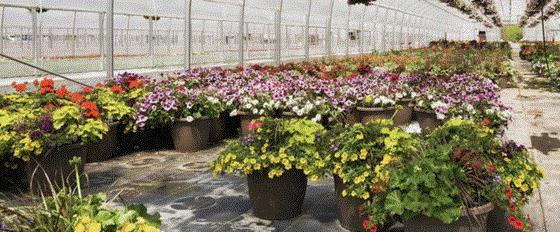
NICK’S TIP: The pH of growing media can increase over time for various reasons, so here are a few things to consider if your pH creeps up and cause issues in your crops.
What’s Your Water Alkalinity?
If your soil pH increases persistently throughout production, your irrigation water’s alkalinity likely has something to do with it. Not to be confused with pH, alkalinity is the buffering capacity of water, i.e. its ability to neutralize acids, which is often reported as meq/L or ppm of CaCO3.
Midwestern growers often face the biggest challenges with high alkalinity (hooray for limestone aquifers!), but other regions have high alkalinity, as well. Carbonates and bicarbonates that make up the alkalinity in your water accumulate in growing media and cause the pH to increase gradually as they react with different acids in the soil column. As such, you need to know your water’s alkalinity and manage it appropriately to avoid high-pH-induced Fe deficiency.
-
If you don’t know what your water’s alkalinity is, collect and submit a water sample to a commercial laboratory. Be sure that the analysis being performed includes alkalinity—not just hardness, as hardness does not provide actionable info for managing alkalinity.
-
Drop-count titration kits offer relatively precise alkalinity readings (if used correctly). If the cost of having a lab analysis is too high, these kits can be purchased for about $50 and shipped to you.
-
Once you have an accurate water alkalinity reading, take proper management steps to reduce alkalinity to suitable levels for crop production. Alkalinity at or below 100 ppm CaCO3 is a good target to shoot for in finished crop production.
-
Check out this info from Purdue University for more details and specific strategies for managing alkalinity.
How Much Lime is in Your Soil?
Dolomitic lime and other lime products are used by substrate manufacturers to stabilize soil pH and keep it within ranges suitable for growing plants over time. While reliable manufacturers have quality control measures to ensure the proper amount of liming agent is added, mistakes can happen. Whether an equipment failure occurred or a spot-check test wasn’t done properly, too much lime in your mix can cause the pH to increase over time and cause high-pH-induced Fe deficiency in your crops. This is less common compared to high water alkalinity driving pH up, but if your water quality is good and/or is being properly managed, look for the following indicators—and test your soil ASAP!
-
Batch-wise patterns. If all your crops are being treated the same and are growing in the same type of media but differences in crop health between one group of plants to the next is apparent, a mixing error may have occurred with the media in which more heavily symptomatic plants are growing. Be sure to save bag/bale/pallet labels with batch numbers on them in case you need to work with your supplier to back trace a batch-wise issue like this.
-
Severity of the issue. If even your high-pH-loving crops like geraniums, marigolds and pentas are showing symptoms of Fe deficiency, your growing media may be over-limed. Be sure to eliminate possible high pH factors on your end (like water quality and other cultural factors) before reaching out to your supplier. This is another scenario where it pays to keep a record of substrate batch numbers to send to your supplier for testing.
In this type of situation, growing media pH might be within an appropriate range early in production. Regimented in-house soil pH tests can help catch issues associated with over-limed soils from sneaking up on you, so be sure to add periodical soil testing to your to-do list.
What's Your Feed?
If your water quality is decent and your growing media lime rate is appropriate, but Fe deficiency still occurs, you may need to adjust your fertilizer program. Use of fertilizers formulated with primarily nitrate-based nitrogen (ex. Cal-Mags [15-5-15 or 17-5-17], 15-0-15, 15-0-0) on a constant basis can drive the soil pH up over time and lead to high-pH-induced Fe deficiency. Be sure to rotate an acid-rendering fert formulation into your feed schedule to combat this.
-
Fertilizers like 20-10-20 have a higher percentage of ammoniacal nitrogen than Cal-Mag feeds (for example), and drive soil pH down over time.
-
In cases where pH needs to be decreased significantly, spot-feeding with a highly acidic fertilizer like 21-7-7 once or twice can be a short-term solution. However, do not apply fertilizers like this to crops that are sensitive to ammonia-form nitrogen (for example, coleus, salvia and zinnia).
Lastly, if you’re using a new feed for any reason this spring, be sure to check the micronutrient levels on the label. If micro levels are lower than in your normal feed or micros are removed entirely, supplement with a micronutrient package at an appropriate rate to prevent Fe deficiency and save yourself from potentially going on a wild goose chase trying to find the cause.

Plan Ahead for Greenhouse Expansion
I’ve talked with a few growers lately who’ve maxed out their production space in the past couple years and are looking to add greenhouses. I’ve also heard from a handful who feel like their facilities are inefficient based on changes in their crop mix (and also just age) and are hoping to upgrade to more modern ranges. Maybe you’re in the same boat and have started considering starting the process of expansion or retrofitting. If so, I HAVE A GREAT PODCAST FOR YOU.
In a past episode of my Tech On Demand podcast I was joined by Paul Golden, Sales Manager for Commercial Growing with Prospiant Inc., to discuss how you should approach the decision to build new greenhouses or retrofit or repurpose your current structures to meet new crop needs or prepare for product mix shifts in the future. We look at many angles this episode, from the physical structure and components inside, to the people who work under the greenhouse roof. Your greenhouse structures serve diverse purposes and impact just about every factor in your business, including the health and success of each crop, as well as labor, efficiency and employee attitudes.
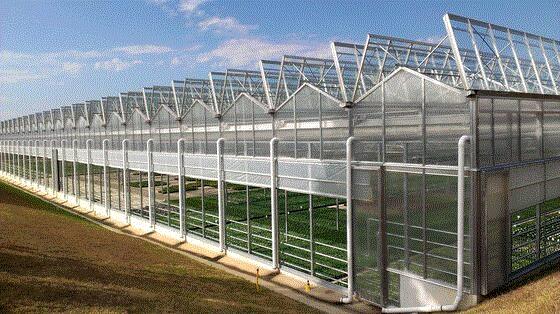
Through this podcast, Paul and I touch on all of these factors and more, moving from the structural functionalities needed for your equipment to how your existing layout impacts labor and efficiency. One key factor to consider when deciding to build new or refresh is the cost of maintenance, so Paul spends plenty of time on this topic. Perhaps shifting these expenses towards a new build is a better bet long-term.
The podcast concludes with a discussion geared toward hybrid businesses, grower/retailers. If you have plans to add a retail component to your business due to increased demand in the past few years, you have a whole new set of considerations, beginning with the fundamental question: Is your greenhouse structurally sound? You also need to think about the shopping environment and whether your current facility is conducive to people who have a far different tolerance for the greenhouse environment than your staff.

Tech Tip: Distorted Petunia Flowers
A grower reached out to the Tech On Demand team last season concerned about flower distortion and odd spots on petunias (check out the photo below to see the symptoms). The team felt this was most likely botrytis, as well as an issue with low calcium availability. Here’s the diagnosis and advice, with a few resources to keep on hand in case a similar problem confronts your production team in the future.
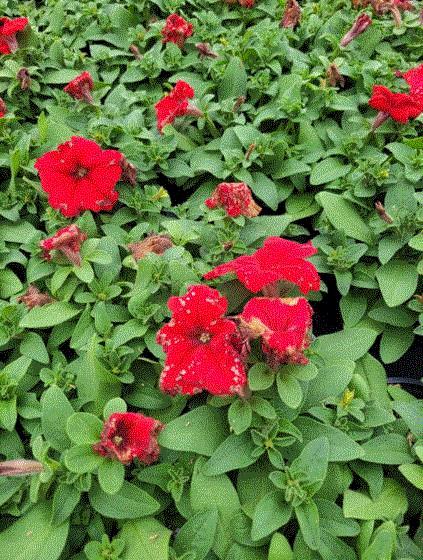
It’s suggested you explore low calcium (first) and botrytis (second) as likely factors. Then run an analysis on your water quality and look at Ca:Mg:Na ratio so you match water treatment and fertility. It’s possible that elevated Na is an issue; or, if you’re using a reverse osmosis (RO) system, it could be low calcium.
For this crop, trial calcium chloride applications (around 800 ppm to start). That’s based on research by Katherine Bennett and Jim Faust, published in GrowerTalks a couple of years ago. Check out STRONGER PLANTS and MAKING CALCIUM WORK FOR YOU.
In addition to considering calcium, you want to up your botrytis prevention game, with both contact and systemic fungicides. This should get these petunias back on track.

Tech Tip: Petunia Blooms … Even Uglier!
The previous tip tackled odd spots and distortion on petunia blooms, but what if you walked out in the greenhouse and saw this:
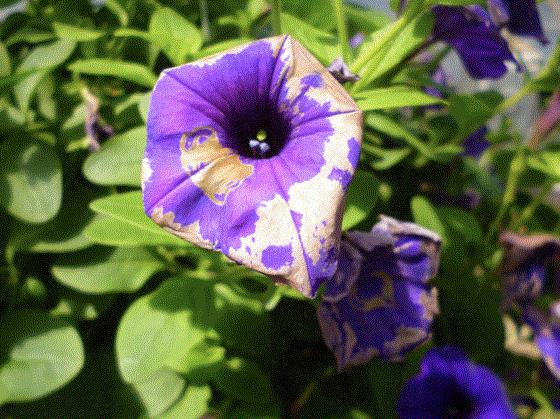
The photo is pretty scary, but the issue is fairly simple to diagnose: it’s phytotoxicity.
Flower blooms can be very sensitive to many sprays. Broad-spectrum insecticides, oils and soaps are common solutions to pest and disease issues, but they can be problematic when applied to stressed plants. If your crops have experienced drought, high heat, cold snaps or other stressful conditions, they will be more susceptible to phyto effects. Limit the stress and your conventional pest and disease control methods should work as expected.
More on Common Causes of Phyto
Let’s dig a bit deeper into phytotoxicity. In a RECENT PESTTALKS NEWSLETTER (a sister newsletter to Tech On Demand, written by JC Chong, Technical Development Manager at SePRO), JC goes in-depth into conditions that predispose plants to phytotoxicity damage. Here’s what JC has to say:
Environmental conditions are intimately tied to phytotoxicity. For example, I generally don’t recommend using horticultural oil when the temperature is above 90F or below 40F. High humidity can also be a problem, because the spray solution will sit on the foliage longer and has a greater chance of causing damage.
One question I get often is, “If I can’t spray horticultural oil when it’s hot, what can I do if that’s the only thing that works against a pest?” Well, spray early in the morning when the temperature is low and the spray solution has more time to dry. Once the solution dries, the oil residue will have a lower chance of causing damage even if the temperature rises to above 90F later in the day. Light level can also cause damage, either through raising the foliage temperature or reacting with the pesticide itself.
Of course, whether a plant species or cultivar you apply it to is sensitive to phytotoxicity or not makes a huge difference. Read pesticide labels carefully, because the labels will provide a list of plant species or cultivars that are known to be sensitive to the products. If the label says not to use this product on this plant species or don’t make more than one application or go above this rate on that species, you better follow the precautions. (Not to mention, the label is the law!) Even if the label doesn’t mention any sensitive plant species or cultivar, it’s a good idea to do a test for phytotoxicity when you use a product on a plant species for the first time.

Plant conditions are also important. Drought-stressed plants are notoriously susceptible to phytotoxicity. But plants that are stressed by disease, insect, frost injury or heat may also be sensitive to one product or another. Stress weakens a plant, and the application of a risky product simply adds insult to injury. It’s important to know that phytotoxicity may appear on certain plant parts (such as flowers or bracts) or at a certain plant age (such as soon after transplant), but not on others because of differences in physiology among these parts and ages.
What you use and how you use it also make a difference. Some products have inherently greater risk of causing phytotoxicity than others. For example, herbicides and plant growth regulators work by changing the normal growth and physiology of plants. Copper and sulfur can impact the physiology of pests and plants. Obviously, you’ll need to use these products more carefully. Some formulations (such as oil-based or emulsifiable concentrates) or surfactants can also cause surprising damage.
Years ago, I tested some plant extracts and damage showed up on annual vinca flower (not leaves) within hours of application. It turned out that the surfactant used in that plant extract reacted with light and caused phytotoxicity.
Also, if the application isn’t done properly, part of the crop or plant can be damaged through overdosing. Again, it’s important to read labels on which product is or isn’t safe to use together or tank-mixed before using the products.
I guess, in some way, you can think of phytotoxicity like a disease—its occurrence also depends on the “phytotoxicity triangle.” You’ll need a causal agent (in this case, a pesticide that has formulation or other properties that increases its risk of phytotoxicity), suitable environmental conditions (high temperature, high relative humidity, etc.) and a susceptible plant (either because it's a sensitive plant species or cultivar or has a condition that predisposes the plant to damage) to tango.
The outcome of the “phytotoxicity triangle” can be drastically different when you change one of the “angles” in this equation. For example, one product may be risky in hot, humid conditions, whereas another product may be more damaging when it's cool and wet. So, each combination of plant, product and environmental condition may have to be considered independently and carefully.

Finish Line …
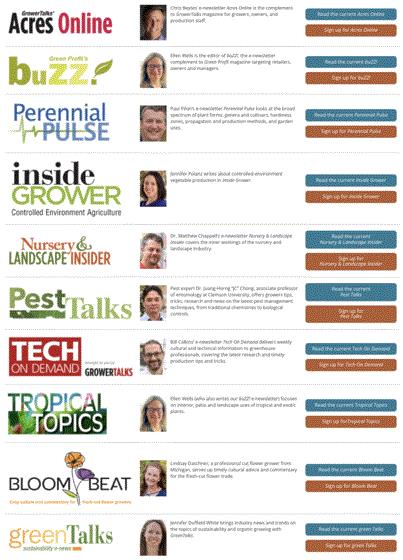
I’ve already referenced two Ball Publishing newsletters in this edition, but did you know Ball Publishing produces TEN e-newsletters, each covering a specific topic or market segment?
That’s right, ten opportunities either weekly or bi-monthly to read timely and relevant news items and stories squarely focused on your business interests.
From perennials to tropical plants and cut flowers to controlled environment agriculture (and our once-a-year CAST coverage), our experienced editors have the best connections in each market to bring you cutting-edge info.
I could go on and on about our e-newsletters because each one is a leader in its field and each editor is passionate about the topic they cover in their own unique way. Instead, I’ll just share a link where you can CHECK OUT ALL OF OUR NEWSLETTERS—sign up to receive the ones you need. And jump back in the archives to read past issues.



Please feel free to send your comments, constructive criticism and topic ideas to me at bcalkins@ballhort.com.

Bill Calkins
Editor - Tech On Demand
This email was received by you and 26,311 other fine subscribers!
If you're interested in advertising in Tech On Demand, contact Kim Brown ASAP and she'll hook you up.